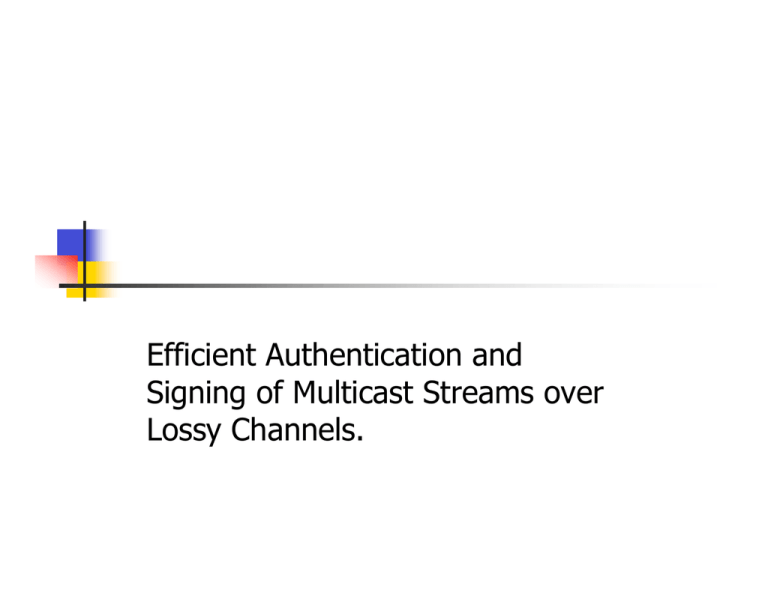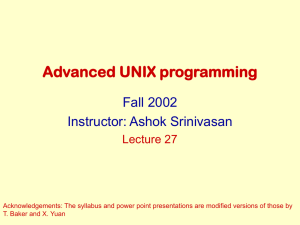Efficient Authentication and Signing of Multicast Streams over Lossy Channels.
advertisement

Efficient Authentication and
Signing of Multicast Streams over
Lossy Channels.
Introduction
n
n
Need for a separate scheme
Two Schemes
n
TESLA
n
n
n
n
n
Sender Authentication
Strong loss robustness
High Scalability
Minimal overhead
EMSS
n
n
n
Non Repudiation
High loss robustness
Low overhead
Need for a separate scheme
n
n
Internet
Need for widespread & trusted streamed
media dissemination
n
n
n
Attacker may alter stock quotes distributed
through IP multicast
Solution is trivial for 1 sender receiver case
Multiple receiver – Need to use asymmetric
cryptography
n
Digital Signatures: Too inefficient
Need for separate scheme
(Contd)
n
n
Needs to scale to millions of users
Streamed media distribution can have
high packet loss
TESLA - Properties
n
n
n
n
n
n
n
Low computational overhead
Low per packet communication overhead
Arbitrary packet loss tolerated
Unidirectional data flow
No Sender side buffering
High guarantee of authentication
Freshness of data
TESLA – Basic working
n
n
n
n
n
n
Timed Efficient Stream Loss – tolerant Authentication
Based on timed release of keys by the sender
Sender commits to a random key k and transmits it
to the receivers without revealing it
Sender attaches a MAC to the next packet Pi with k
as the MAC key
In Pi+1 packet sender decommits to the key and
receiver uses this key k to verify Pi
Need a security assurance
TESLA – Scheme I
n
n
n
n
n
n
n
Pi-1 = <Di-1, MAC(K’i-1 , Di-1)>
Di-1 = <Mi-1, F(Ki), Ki-2>
Mi-1 = Message
F(Ki) = commitment to Ki
K’i = F’(Ki)
Each packet Pi+1 authenticates Pi
Problems ??
TESLA – Scheme I (Contd)
TESLA – Scheme I (contd )
n
n
If attacker gets Pi+1 before receiver
gets Pi, it can forge Pi
Security Condition
n
n
n
ArrTi + delta(t) < Ti+1
Sender’s clock is no more than delta(t)
secs ahead of that of the recievers
Packet loss not tolerated
TESLA – Scheme II
n
n
n
n
n
n
n
n
Generate a seq of keys { Ki }
Fv(x) = Fv-1( F(x) )
Fo(x) = x
Ko = Fn (Kn)
Ki = Fn-i(Kn)
Attacker cannot invert F & compute any Kj
given Ki; j>I
Receiver can compute all Kj from Ki ; j < I
Kj = Fi-j (Ki) ; K’i = F’ (Ki)
TESLA – Scheme II (Contd)
TESLA – Scheme III
n
n
n
n
n
n
Deals with faster packet rates
Does not require that sender waits for
receiver to get Pi before it sends Pi+1
Disclose Ki in Pi+d instead of Pi+1
d = (delta(t)max + dnmax)/r
r = packet rate
Security Condition:
n
n
n
ArrTi + delta(t) < Ti+d
Very short d = ?
Very large d = ?
TESLA – Scheme IV
n
n
n
n
n
Deals with Dynamic transmission rates
Divide time into intervals
Use the same Ki to compute the MAC of
all packets in the same interval i
All packets in the same interval disclose
the key Ki-d
Achieve key disclosure based on interval
basis than on packet index basis
TESLA – Scheme IV (contd)
TESLA – Scheme IV (contd)
n
n
n
n
i = (t – To)/Tdelta
Ki’ = F’(Ki) for each packet in interval i
Pj = < Mj, i, Ki-d, MAC(Ki’, Mj) >
Security condition:
n
n
n
i + d > i’
i’ is the interval the sender can be at most
i’ = (tj+delta(t)-To)/Tdelta
TESLA – Scheme V
n
n
n
n
n
Allow for a broad spectrum of users
d is short shall force remote users to drop
packets
d is large shall cause unacceptable delay for
fast receivers
Use multiple authentication chains with
different values of d
Receiver verifies one security condition for
each chain Ci, and drops the packet is none is
satisfied
EMSS
n
n
Efficient Multichained Streamed Signature
Useful where
n
n
n
n
Non Repudiation required
Time synchronization may be a problem
Based on signing a small no. of special
packets in the stream
Each packet linked to a signed packet via
multiple hash chains
EMSS – Basic Signature Scheme
EMSS – Basic Signature Scheme (Contd)
n
n
Sender sends periodic signature packets
Pi is verifiable if there exists a path
from Pi to any signature packet Sj
EMSS – Extended Scheme
n
n
Basic scheme has too much redundancy
Split hash into k chunks, where any k’ chunks
are sufficient to allow the receivers to validate
the information
n
n
n
n
Rabins Information Dispersal Algorithm
Some upper few bits of hash
Requires any k’ out of k packets to arrive
More robust
Related Work
n
Gennaro and Rohtagi 1997
n
n
n
Include in Pi the hash of pi+1
Does not tolerate packet loss
Wong and Lam 1998
n
n
Use one signature generation & verification
over multiple messages
Larger space overheard
Related Work (Contd)
n
Syverson et al. 1997
n
n
n
n
Asymmetric and unlinkable authentication
Use a blinded signature token, authenticated
every transaction
Substantial computational and communication
overhead
Anderson et al. 1998
n
n
Guy Fawkes protocol
Improvise on it, to make it more efficient.
Related Work (Contd)
n
Rohatgi 1999
n
n
n
Use k time signature scheme
Uses a 6 time public key and 300 bytes for each
signature
Cannetti et al. 1999
n
n
n
Sender authentication scheme for multicast
Use k different keys to authenticate every
message with k different MACs
More Expensive
Conclusions
n
n
n
Low computational overhead
Low communication overhead
Loss robustness
Future Work
n
n
n
This paper does not issue DoS attack
TESLA may suffer from time
synchronization issues
Present Schemes require buffering
packets at receiver side






